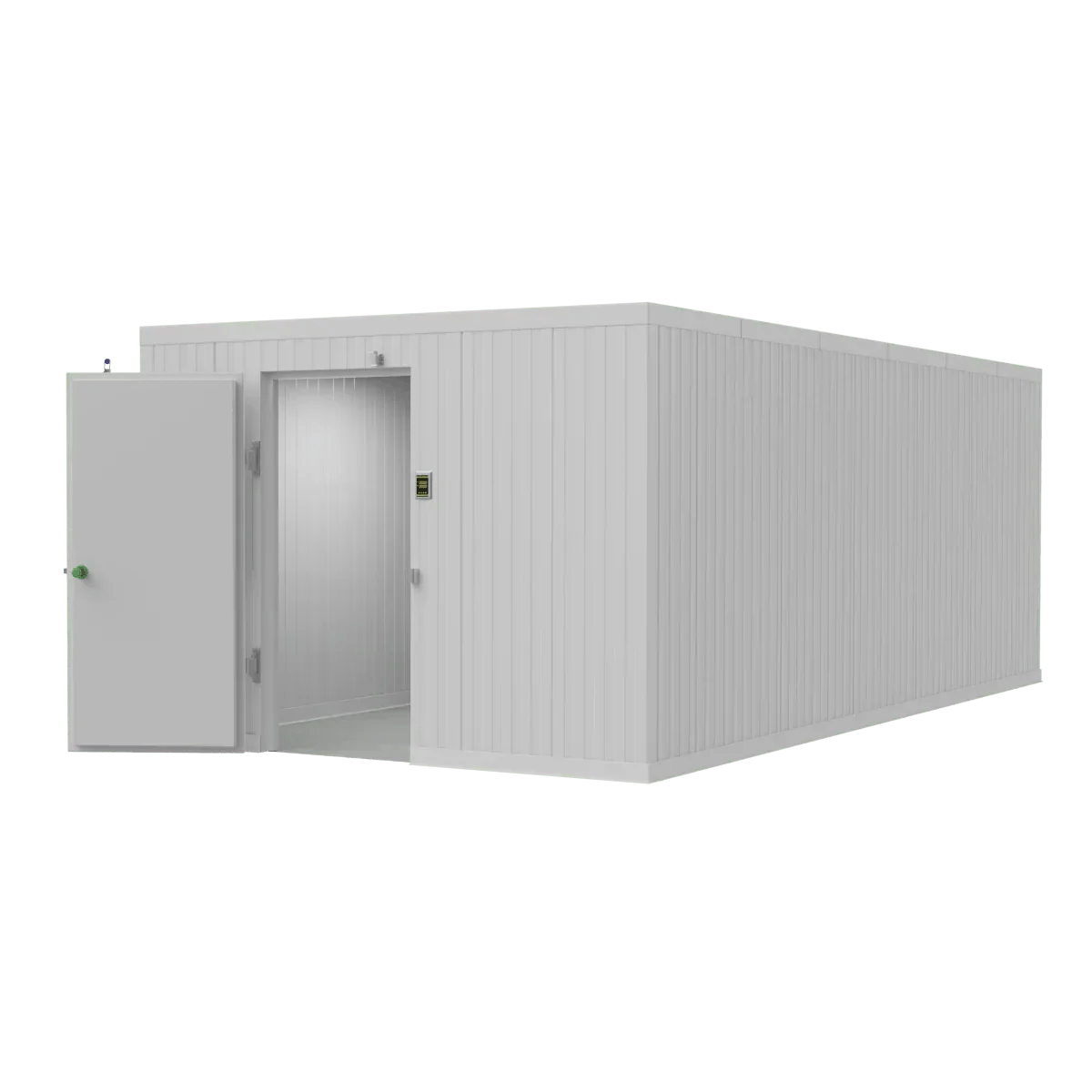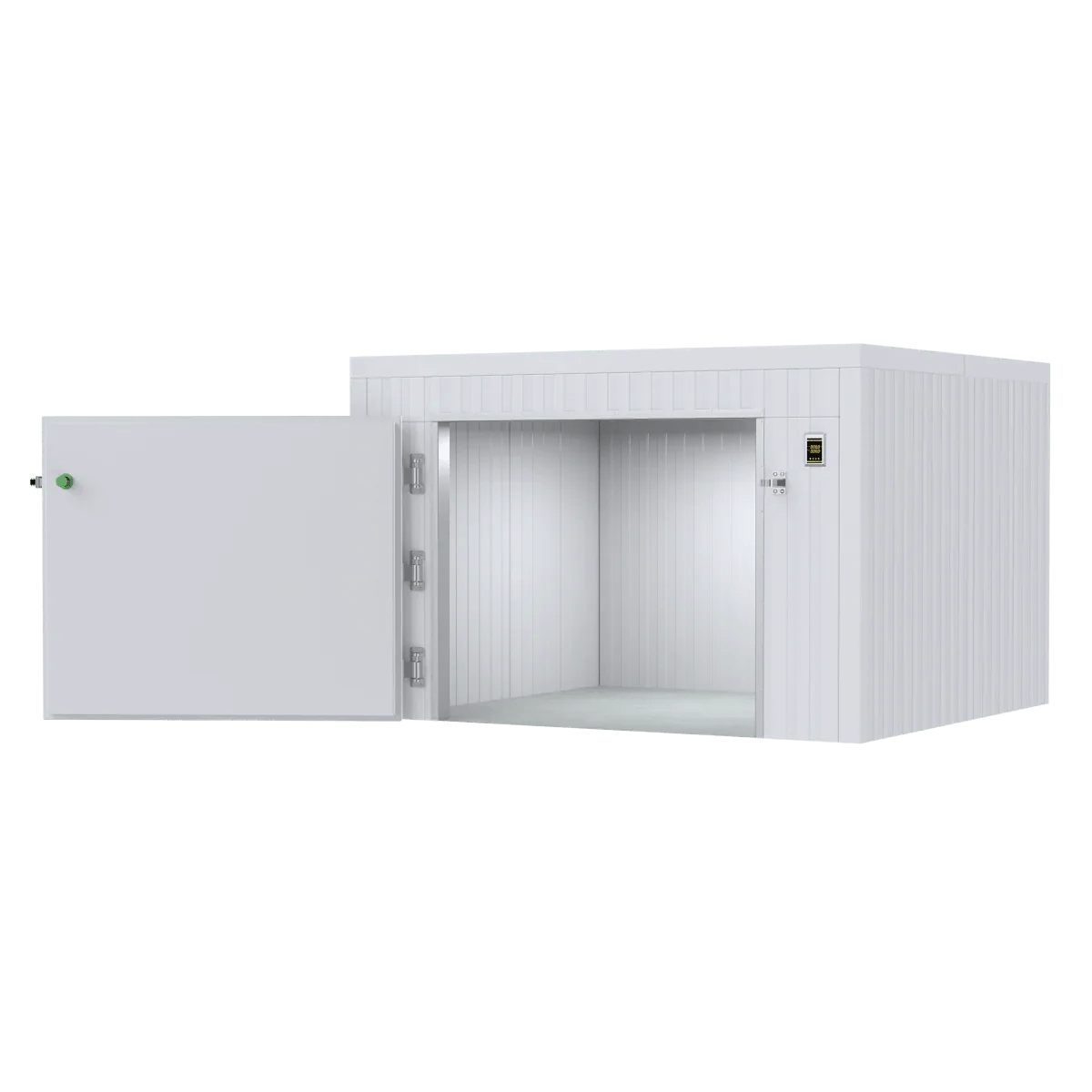Maximizing Function in Minimal Space
An ottoman desk is a versatile piece of furniture that combines seating with a work surface, perfect for small spaces where traditional desks won't fit.
What is an ottoman desk?
- A multifunctional piece that serves as both seating and a workspace
- Features a cushioned base with either a hinged lid or lift-top surface
- Typically includes hidden storage compartments
- Supports weights up to 300 lbs while providing ergonomic benefits
- Available in various styles from $50 budget options to $400+ designer pieces
The concept of an ottoman desk brilliantly solves the challenge of limited square footage in today's compact living environments. Originating from portable writing desks of the 16th century, these ingenious furniture hybrids have evolved to meet modern needs for flexible, space-efficient workspaces.
Whether you're working from a studio apartment, dorm room, or simply need an occasional workspace that doesn't dominate your living area, an ottoman desk offers the perfect balance of functionality and space-saving design.
The beauty of an ottoman desk lies in its seamless transition between functions - one moment it's extra seating or a footrest, the next it's a productive workspace with storage for supplies. This adaptability makes it an increasingly popular choice for those seeking to maximize every square inch without sacrificing comfort or style.
I'm Mortuary Cooler, a furniture space optimization specialist with over 15 years of experience helping clients integrate multipurpose pieces like the ottoman desk into challenging floor plans. My expertise in maximizing functionality in limited spaces has helped countless professionals create productive work environments regardless of spatial constraints.
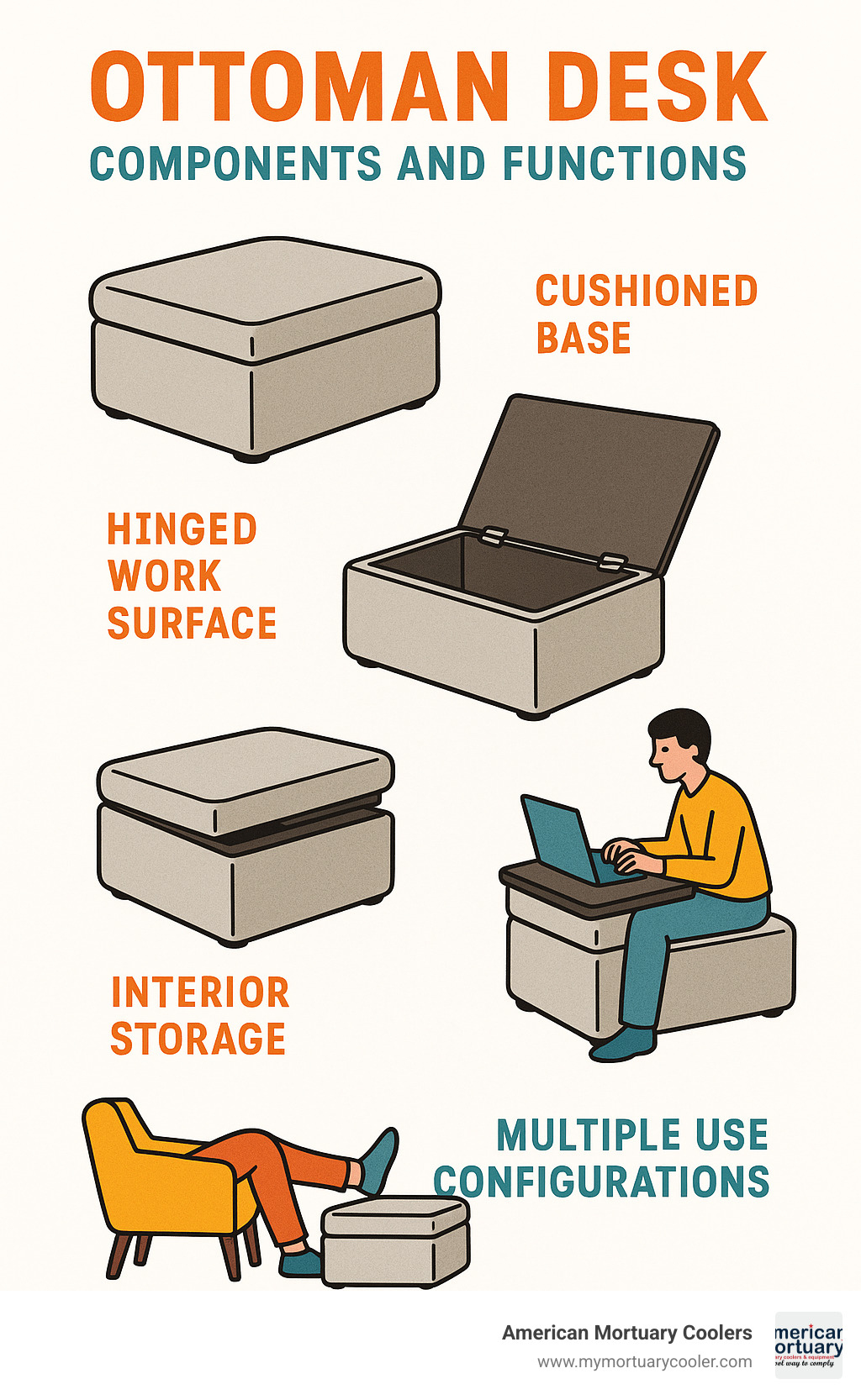
Simple guide to ottoman desk:
Ottoman Desk 101: Definition, History & Evolution
The journey of the ottoman desk is a fascinating tale that winds through centuries of furniture design, blending practicality with comfort in ways our ancestors might never have imagined.
Back in late 16th century England, the earliest relatives of today's ottoman desk made their debut as portable writing surfaces. These clever table desks weren't meant to stand alone but rather to be placed atop existing tables, allowing writers to work while standing. Museum collections show these early desks featured ingenious storage solutions – some containing up to eight small drawers for quills, ink, and parchment. This marriage of storage and workspace laid the groundwork for what would eventually become the modern ottoman desk.
"The writing desk developed in England at the end of the 16th century as a portable workstation," as one museum curator puts it. These weren't merely functional pieces – they often showcased exquisite craftsmanship with decorative inlays, including the distinctive Nonsuch style inspired by Henry VIII's palace.
While English craftsmen were perfecting their designs, the Ottoman Empire was developing its own tradition of portable writing desks. These weren't just tools but treasured art objects, crafted with such skill that they command impressive prices even today. In 2021, an Ottoman portable desk from the late 16th century sold at a Paris auction for an estimated €25,000 to €30,000 – proof that good design truly is timeless!
The Victorian era brought us closer to what we'd recognize as an ottoman desk today. The pouffe – that plush, upholstered seating piece – began to incorporate writing surfaces. These pouffe desks brilliantly combined comfortable seating with practical workspace, a concept that modern furniture designers haven't abandoned but rather refined.
Today's ottoman desks represent the perfect evolution of these ideas – the storage functionality of those early writing boxes with the comfort of upholstered ottomans, creating truly versatile pieces that fit our contemporary space-conscious lifestyles.
Ottoman Desk vs Traditional Desk – Key Differences
When shopping for workspace furniture, understanding what makes an ottoman desk unique compared to its traditional counterpart can help you make the right choice for your needs.
Traditional desks stand tall at 28-30 inches and require a separate chair, while an ottoman desk sits considerably lower (typically 16-20 inches) and can be used while seated on the floor, on the ottoman itself, or from a nearby chair or sofa. This height difference fundamentally changes how you interact with your workspace.
The ottoman desk's legless profile is a game-changer for small spaces. Without those four legs extending to the floor, you gain valuable floor space and can easily reposition your workspace as needed – something a traditional desk simply can't offer.
Storage looks different too. Rather than side or front drawers, an ottoman desk typically features nested storage accessed by lifting the entire top surface. This creates a different organizing experience that many find more intuitive for certain types of work.
As one interior designer aptly notes, "The beauty of an ottoman desk is that it doesn't announce itself as office furniture. When closed, it's just a beautiful upholstered piece that contributes to your living space aesthetics." This visual versatility gives the ottoman desk a distinct advantage in multipurpose rooms.
Perhaps most importantly, traditional desks serve primarily one function, while an ottoman desk smoothly transitions between multiple uses – seating when guests arrive, footrest when you're relaxing, table surface for snacks, and productive workspace when duty calls.
Ottoman Desk vs Standard Ottoman – Why the "Desk" Matters
At first glance, a standard ottoman and an ottoman desk might look like twins, but look closer and you'll spot the meaningful differences that make one a true workspace solution.
The most crucial distinction is the work surface. A standard ottoman typically has a soft, fully upholstered top that's perfect for propping up your feet but woefully inadequate for writing or supporting a laptop. An ottoman desk, by contrast, incorporates a rigid, stable surface that won't wobble or sink when you're in the middle of an important project.
The storage inside tells another story. While standard ottomans might offer basic storage for blankets or magazines, an ottoman desk includes thoughtfully designed compartments, sometimes with dividers or trays specifically sized for office supplies, electronic devices, and important documents.
Both pieces might support similar weight for sitting (typically up to 300 lbs), but an ottoman desk is engineered differently – it's built to handle the sustained pressure of writing or typing without warping or deforming over time.
Many ottoman desks also incorporate ergonomic elements like angled surfaces for comfortable writing, wrist supports, or device stands that you'd never find in a standard ottoman. And in our connected world, features like grommets or channels for cable management make the ottoman desk distinctly more workspace-friendly.
These thoughtful distinctions make the "desk" in ottoman desk more than marketing fluff – it represents specific design considerations that transform a simple seating piece into a genuinely functional workspace.
Timeline: From 1580 Table Desk to 2024 Smart Pouffe
The evolution of the ottoman desk reads like a fascinating furniture history lesson spanning nearly 450 years:
Between 1580-1620, the first English table desks appeared, crafted from oak and boxwood with decorative inlays. These portable writing surfaces included clever storage for quills and ink, designed to sit atop existing tables rather than stand alone.
Around the same time, Ottoman Empire craftsmen were creating their own portable writing desks featuring stunning tortoiseshell and ivory marquetry. These weren't just functional pieces but status symbols for the educated elite.
By the 18th century, the writing box had evolved to include more sophisticated storage systems while maintaining its essential portability. These boxes were the laptops of their day – personal workstations you could take anywhere.
The Victorian era of the mid-19th century saw furniture designers beginning to incorporate writing surfaces into upholstered seating, creating the first pouffe desks that combined comfort with functionality – a direct ancestor to today's ottoman desk.
Early 20th century modernist designers experimented with multifunctional furniture, including storage ottomans with removable trays that doubled as work surfaces. The 1950s and 60s acceptd space-saving furniture as mid-century modern design flourished, leading to more refined ottoman-desk hybrids for growing suburban homes.
By the 1990s and 2000s, IKEA and similar manufacturers began mass-producing affordable storage ottomans and pouffes, making the concept accessible to average consumers. The 2010s saw interest in multifunctional furniture accelerate with the rise of small-space living and remote work, with ottoman desks gaining popularity among apartment dwellers and minimalists.
The COVID-19 pandemic between 2020-2023 created unprecedented demand for home office solutions. According to online marketplace data, some ottoman desks sold on platforms like Amazon were purchased over 10,000 times in a single month during this period, as people sought workspace solutions that could be tucked away when not in use.
In 2024, we're seeing the emergence of smart pouffe technology, with ottoman desks now incorporating USB charging ports, wireless charging surfaces, and integrated lighting systems – truly bringing this centuries-old concept into the modern age.
This fascinating progression shows how the ottoman desk has continuously adapted to our changing work styles, living arrangements, and technological needs while staying true to its core dual-purpose nature.
Key Functions & Benefits: Space-Saving, Ergonomics & Storage
Let's face it—the real magic of an ottoman desk is how much it can do while taking up so little space. It's like the Swiss Army knife of furniture!
These clever pieces typically have a footprint of just 30 inches square, which is dramatically smaller than traditional desk setups that gobble up 40-60 inches of precious wall space. This space-saving superpower comes from eliminating the need for a separate chair and tucking all your storage inside the ottoman base.
Interior designer Marla Feldman puts it perfectly: "I recommend ottoman desks to clients who need occasional workspace but can't dedicate a permanent corner to a traditional desk. They're perfect for that studio apartment where every square foot counts."
The beauty of an ottoman desk is its chameleon-like ability to transform. One minute it's your productive workspace, the next it's extra seating when friends drop by, and later it becomes your footrest while binging your favorite shows. Add a decorative tray, and voilà—it's now a coffee table!
Most models are built to support up to 300 pounds, making them sturdy enough for adult seating while remaining light enough to move around when you're rearranging your space. This weight capacity ensures stability whether you're typing away on your laptop or writing in your journal.
Perhaps the most satisfying aspect is the hidden storage. Unlike traditional desks with visible drawer fronts announcing "office stuff here," an ottoman desk keeps everything neatly concealed within its upholstered exterior. Your space stays looking clean and uncluttered, even when the ottoman is packed with supplies.
Space-Saving Superpowers in Small Homes & Offices
The space-efficiency of an ottoman desk truly shines in challenging living situations:
In studio apartments, where every inch matters, your ottoman desk can serve triple duty—guest seating by day, workspace when needed, and footrest in the evening. One piece of furniture instead of three? That's a win for your square footage and your wallet.
College dorm rooms are notoriously cramped, but an ottoman desk gives students a place to study without sacrificing precious floor space. When friends visit for study sessions (or, let's be honest, pizza parties), it instantly converts to extra seating.
For those of us working from home without a dedicated office, an ottoman desk in the living room or bedroom lets you "close the office" at day's end simply by closing the lid. Work-life balance made tangible!
Some particularly clever designs even fold completely flat when not in use, allowing you to store them under a bed or against a wall—perfect for those truly tiny spaces or when you need to temporarily reclaim floor space for activities.
One enthusiastic reviewer captured it perfectly: "My New York apartment barely fits a bed and sofa, but this ottoman desk gives me a place to work without making my home feel like an office. When I'm done, I close it up, and it's just a cute ottoman again."
For more clever space-saving ideas, check out this guide to space-saving dressing tables for small rooms.
Ergonomic & Comfort Gains of an Ottoman Desk
While traditional ergonomics focuses on conventional desk setups, ottoman desks offer their own unique comfort benefits:
Many models feature adjustable height blocks that let you find your ideal working position. This flexibility helps prevent the stiffness and discomfort that comes from maintaining a single posture for hours on end.
When used as a footrest under your regular desk, an ottoman desk can provide significant lumbar relief by supporting proper foot positioning. Some models designed specifically as under-desk footrests include contoured surfaces that promote healthy posture throughout your workday.
The upholstered nature of ottoman desks means they're typically much more comfortable against your body than hard desk surfaces. Many feature memory foam padding that gently conforms to your body—something your standard desk and chair combo simply can't offer.
Practical comfort extends to maintenance too. Many ottoman desks come with removable, washable covers—a feature rarely found in traditional desks. This is particularly valuable for households with children, pets, or if you're just prone to coffee spills (we've all been there!).
Higher-end models often feature OEKO-TEX certified fabrics, ensuring they're tested for harmful chemicals and safe for direct skin contact—important for furniture you might sit on or rest your bare feet against.
As one ergonomist notes, "The ability to change positions throughout the day is one of the best ways to prevent discomfort. An ottoman desk naturally encourages this variability by allowing users to work from different positions and heights."
Storage Face-Off: Ottoman Desks vs Other Solutions
When comparing storage capabilities, ottoman desks have some distinct advantages over other furniture solutions:
| Feature | Ottoman Desk | Console Desk | Storage Bench |
|---|---|---|---|
| Hidden Storage | ✓ Complete concealment | ✘ Visible drawers | ✓ Under-seat only |
| Access Method | Top-lifting lid | Pull-out drawers | Hinged top |
| Storage Volume | 2-3 cubic feet | 1-2 cubic feet | 3-5 cubic feet |
| Organization | Compartmentalized | Drawer dividers | Usually single cavity |
| Dual Functionality | ✓ Seating + workspace | ✘ Workspace only | ✓ Seating only |
| Average Footprint | 30" × 30" | 40" × 20" | 48" × 18" |
The hinged or lift-top design of most ottoman desks gives you easy access to the entire storage area—unlike drawer-based storage that limits the size of what you can store. This design also means you can see all your contents at once, rather than rummaging through multiple drawers trying to find that one pen that always disappears.
Many ottoman desks feature interior compartments similar to shoe-box dividers, creating dedicated spaces for different supplies. This prevents smaller items from getting lost in the abyss of a larger storage cavity (goodbye, forever-lost paper clips!).
One particularly clever innovation in some ottoman desks is the inclusion of document pockets on the underside of the lid. This keeps important papers flat and accessible without consuming the main storage area—perfect for keeping bills or that half-finished manuscript within easy reach.
Professional organizer Tina Martell observes, "I've found that clients consistently underestimate how much they can store in an ottoman desk. The cubic volume is often comparable to a small filing cabinet, but with the flexibility to store oddly shaped items that wouldn't fit in traditional office storage."
With their compact footprint, multi-functional design, and generous hidden storage, ottoman desks truly deliver maximum value per square inch—making them the perfect solution for today's smaller living spaces.
Materials, Construction & Sustainability
When you're shopping for an ottoman desk, understanding what it's made of can make all the difference in how long it lasts and how well it serves your needs. The materials and construction aren't just about looks—they determine whether your new piece will be a lasting investment or a short-term solution.
Most ottoman desks you'll find today combine sturdy structural elements with comfortable materials that make them pleasant to use. The frame—the skeleton of your desk—typically comes in solid wood like pine or poplar for budget options, or premium hardwoods in higher-end models. Many affordable options use engineered wood or MDF (that's Medium Density Fiberboard), which offers good stability at a lower price point.
"I always tell customers to check the joints," says furniture craftsman Michael Torres. "A quality ottoman desk with mortise-and-tenon joinery will outlast one held together with just screws and staples by years, maybe even decades."
The outer covering is where your ottoman desk gets its personality. Synthetic leather (often called PU leather) offers a leather look with easier maintenance and a smaller price tag. Real leather provides premium durability and develops a beautiful character over time. Fabric options like linen, polyester, velvet, and the increasingly popular bouclé each bring their own combination of texture, durability, and style to your space.
Underneath that covering, you'll find the padding that makes your ottoman desk comfortable for sitting. Memory foam contours to your body for maximum comfort, though high-density polyurethane foam often lasts longer under regular use. Some eco-conscious manufacturers even use natural cotton batting, though this is less common.
The desk surface itself—the part you'll actually work on—is typically wood or laminate, with some creative designs incorporating materials like cork or linoleum for a softer writing surface. And don't overlook the hinges! They're the unsung heroes of any ottoman desk, bearing the stress of opening and closing. Look for fold-flat hinges that open to 180 degrees and soft-close mechanisms to protect both the furniture and your fingers.
As sustainability becomes more important to consumers, manufacturers have responded with greener options. Many ottoman desks now feature FSC-certified timber from responsibly managed forests. Look for upholstery with the OEKO-TEX STANDARD 100 certification, which ensures every component has been tested for over 1,000 harmful chemicals.
Popular Material Combos & Weight Ratings
Some material pairings just work better together, creating ottoman desks that are as practical as they are beautiful.
The most common combination you'll find is engineered wood with faux leather covering. This practical pairing gives you good durability and easy cleaning without breaking the bank. Most can support around 250 pounds and stand up well to everyday use. One step up, ottoman desks that pair solid hardwood frames with genuine leather offer exceptional durability and develop a gorgeous patina over time. These premium options often support 300 pounds or more and can become family heirlooms.
For those with more bohemian taste, rattan frames with cotton upholstery create a lightweight, airy feel while still supporting 200-250 pounds. The natural materials appeal to eco-conscious decorators who want to bring texture into their spaces. More contemporary designs might feature powder-coated steel frames with performance fabrics, creating industrial-chic pieces that can handle 300+ pounds while maintaining a sleek profile.
"We test our ottoman desks for both static and dynamic weight," explains furniture designer Leila Mendez. "Static testing measures how much weight the piece can hold when someone's just sitting, while dynamic testing simulates someone plopping down with force. Both matter for real-world use."
Green Credentials & Certifications to Look For
If sustainability matters to you, there are several certifications that can help guide your ottoman desk purchase:
FSC Certification ensures wood comes from responsibly managed forests that provide environmental, social, and economic benefits. This is the gold standard for sustainable wood sourcing.
OEKO-TEX STANDARD 100 guarantees that every textile component has been tested for harmful substances. This is particularly important for furniture you'll be in close contact with.
GREENGUARD Gold certification identifies products with minimal chemical emissions, contributing to better indoor air quality in your home or office.
Beyond certifications, look for ottoman desks with low-VOC or no-VOC finishes on wood components. These volatile organic compounds can off-gas into your home for years, so minimizing them is better for your health.
Some forward-thinking manufacturers now incorporate recycled materials into their ottoman desks. Foam made from recycled content or fabrics woven from reclaimed plastic bottles reduce environmental impact while still delivering comfort and style. Water-based adhesives are another eco-friendly feature, replacing traditional petroleum-based glues with less toxic alternatives.
"Our customers care about what's in their furniture almost as much as how it looks," says Erica Chen of Green Home Furnishings. "We've found that using recycled foam actually creates a more consistent comfort level while keeping materials out of landfills—it's a win-win."
If you're sensitive to chemicals or just concerned about indoor air quality, consider "off-gassing" your new ottoman desk before bringing it fully into your living space. Leave it in a well-ventilated garage or covered outdoor area for several days to allow initial chemical odors to dissipate.

Style, Finish & Interior Integration
An ottoman desk isn't just a practical solution for small spaces—it's also a design statement that can improve your interior aesthetic. With styles ranging from sleek modern to cozy traditional, there's an ottoman desk that will complement any home's personality.
When shopping for an ottoman desk, you'll find a delightful array of design options that reflect current interior trends while offering timeless appeal. Mid-century walnut finishes bring warmth and vintage charm, while Scandinavian-inspired neutrals offer clean simplicity that works in almost any setting. For those who love a bit of luxury, glam velvet ottoman desks in rich jewel tones add a touch of sophistication, especially when accented with brass or gold hardware.
Farmhouse enthusiasts aren't left out either—distressed white finishes with simple lines provide that coveted rustic charm while serving double-duty as functional workspace. And if you're keeping up with current trends, boucle fabric ottoman desks offer irresistible texture that's both on-trend and surprisingly practical.
"I always tell my clients to think about how their ottoman desk will integrate with their existing pieces," says interior designer Maya Henderson. "The beauty of these versatile pieces is that they can either blend seamlessly or serve as an intentional accent—it's all in how you style them."
Matching an Ottoman Desk to Your Décor Scheme
The chameleon-like nature of an ottoman desk allows it to work harmoniously in various settings throughout your home. In home office corners, a well-chosen ottoman desk can provide supplementary workspace without the corporate feel of traditional office furniture. The key is selecting finishes that echo your primary desk or shelving for a cohesive look.
For living rooms, an ottoman desk can brilliantly replace a conventional coffee table, offering hidden storage and a work surface when needed, then changing back to an neat seating piece when guests arrive. The dual functionality shines here, but in this prominent position, aesthetics matter just as much as function.
Bedrooms benefit from ottoman desks too, where they can serve as vanity stations during morning routines or as cozy spots for evening journaling. The intimate nature of bedroom spaces often calls for softer materials—think plush velvet upholstery in calming tones that promote relaxation while still providing practicality.

When incorporating an ottoman desk into your existing décor, consider these designer-approved strategies: choose upholstery colors that appear elsewhere in your room for visual connection; ensure the scale feels proportionate to surrounding furniture; and don't be afraid to mix design eras if the pieces share at least one common element like texture or finish.
Color & Finish Trends for 2024
If you're looking to stay current with your ottoman desk selection, 2024 brings several notable trends worth considering. Sage green has emerged as the new neutral darling, offering subtle color that works beautifully across design styles from contemporary to traditional. This nature-inspired hue brings a sense of calm to work areas while providing more personality than standard beige or gray.
Hardware finishes are seeing a shift toward matte black for a contemporary edge, while brass nailheads and accents add warmth and sophistication to upholstered pieces. These metallic touches lift even simple ottoman desks into statement pieces that catch the eye.
For wood components, we're seeing a welcome return to warmer tones after years of cool gray dominance. Honey, amber, and medium brown finishes bring natural warmth that makes spaces feel more inviting—perfect for creating comfortable work environments.
Perhaps the biggest fabric story of 2024 continues to be boucle, with its irresistible nubby texture appearing on ottoman desks across price points. "We can barely keep our cream boucle models in stock," notes furniture retailer James Wilton. "Customers love how the texture adds interest while the neutral color works with virtually everything."
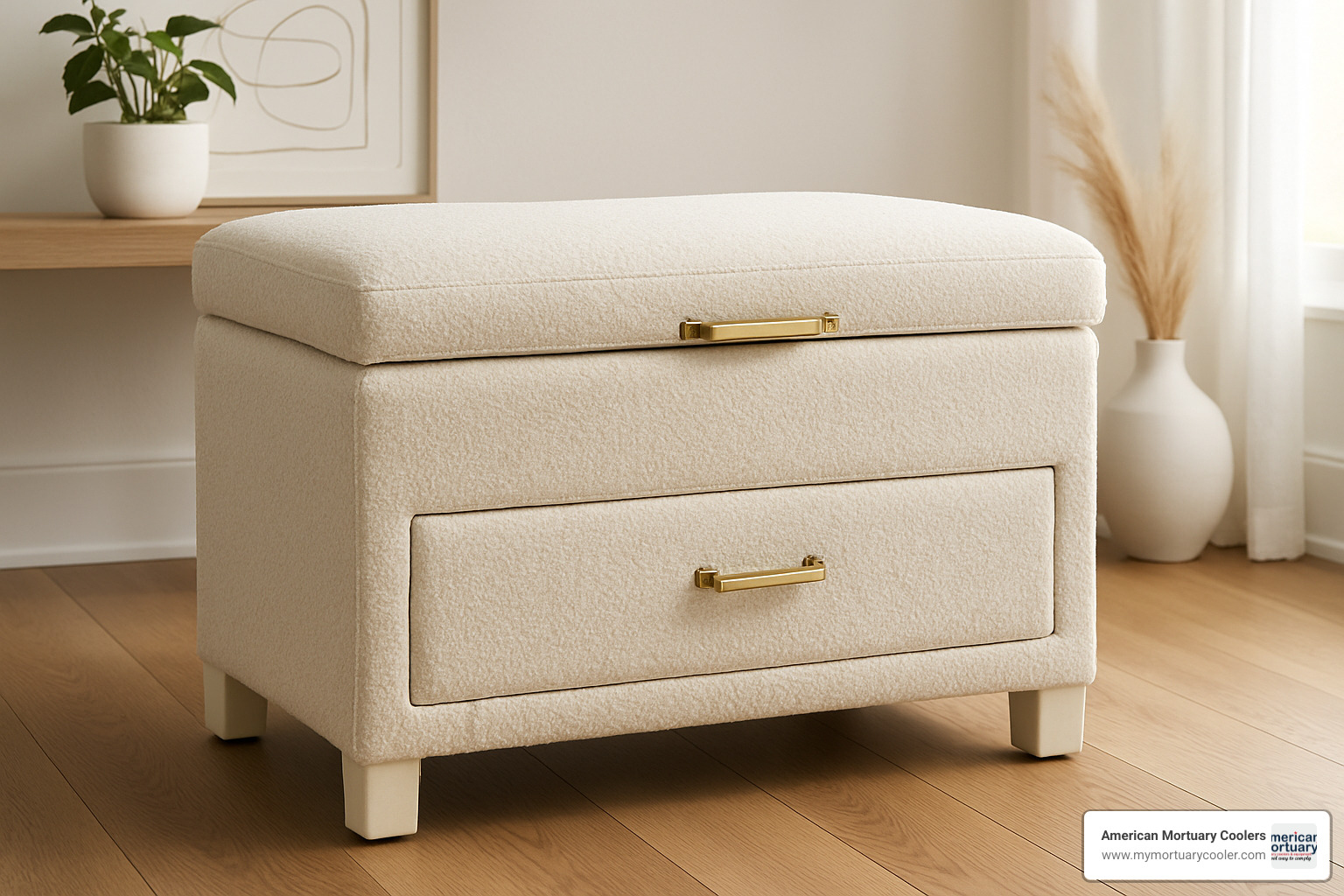
Performance fabrics are gaining ground too, as consumers recognize the practical benefits of stain-resistant, easy-clean materials for multi-use furniture. These technical textiles now convincingly mimic the look of more delicate materials like linen and velvet, offering the best of both worlds—beauty and durability—for busy households.
Whether your style leans traditional or contemporary, there's an ottoman desk finish that will harmonize with your space while providing the functionality you need. The key is choosing a piece that feels like a natural extension of your existing décor—one that you'll enjoy looking at even when it's not being used as a workspace.
Buying, Maintaining & Pricing Your Ottoman Desk
Shopping for an ottoman desk should be exciting, not overwhelming! Let's walk through everything you need to know to find the perfect piece for your space and keep it looking great for years to come.
When I was helping my sister choose an ottoman desk for her tiny Brooklyn apartment, we learned that measuring twice saves a lot of headaches. Always check the dimensions carefully—not just the footprint, but also how much clearance you'll need when the lid opens. Don't forget about knee room if you'll be sitting at it to work!
Assembly is another practical consideration. While some ottoman desks arrive fully assembled (a blessing for the tool-averse among us), others might require your inner handyman to emerge. I always recommend scanning the reviews to see if other buyers found assembly straightforward or frustrating.
Warranty coverage varies dramatically across price points. Budget models typically offer just 90 days of limited coverage, while premium pieces might come with 10-year comprehensive warranties. Pay special attention to what they say about hinges—these moving parts are usually the first to show problems.
"I always tell my clients to test both functions," says furniture consultant Maria Chen. "An ottoman desk needs to be comfortable for sitting and practical as a workspace. Make sure the return window gives you time for real-world testing."
The price spectrum for ottoman desks is surprisingly wide:
Budget Tier ($50-$150): These entry-level options typically feature engineered wood frames and synthetic upholstery. They'll do the job, but might lack organizational features or have limited weight capacity. Perfect for occasional use or dorm rooms.
Mid-Range ($150-$300): Here's where you'll find improved materials, better storage organization, and more attractive styling. Many include thoughtful extras like cable management or device stands. This sweet spot offers good value for most households.
Premium ($300-$500): These models feature quality materials, sophisticated mechanisms like gas lifts, premium upholstery, and robust warranties. Worth the investment if you'll use it daily.
Luxury/Designer ($500+): For the design-conscious, these pieces incorporate premium materials, exceptional craftsmanship, and exclusive styling. Some feature smart technology integration or custom specifications.
And for the history buffs or serious collectors, antique Ottoman portable desks can command astonishing prices—up to €25,000 for historically significant pieces with exceptional craftsmanship.
Size, Weight & Capacity Checklist
Before clicking "buy," take a moment to verify some critical specifications for your ottoman desk.
First, measure your available space carefully, allowing room to move around the piece comfortably. The height matters tremendously for comfort—standard ottoman desks range from 16-20 inches tall when closed, but your ideal height depends on your body size and how you plan to use it.
Don't be fooled by appearances when it comes to storage! Some impressively large ottoman desks have surprisingly shallow storage compartments. Always check the internal dimensions to ensure your items will fit.
The work surface area needs to accommodate your typical work tools—whether that's a laptop, notebook, or art supplies. There's nothing more frustrating than finding your workspace just a few inches too small.
Weight capacity matters in two ways: how much the ottoman desk can support when used as seating (typically 250-300 pounds for quality pieces) and how much weight the work surface can bear (which may be less than the seating capacity).
"Here's a tip most people overlook," shares furniture delivery specialist Jake Martinez. "Before your ottoman desk arrives, measure the entire path from your door to its final destination. You'd be surprised how many people forget about tight hallways or staircases until delivery day!"
Storage & Feature Must-Haves
The beauty of an ottoman desk lies in its clever features that transform it from simple furniture to functional workspace. Depending on how you plan to use yours, certain elements can dramatically improve its usefulness.
Internal dividers make all the difference when organizing supplies. Rather than digging through a jumble of items, these compartments create dedicated spaces for different categories. Some models include removable trays that double as portable mini-desks—perfect for when you want to work from the couch.
For tech lovers, built-in device stands position tablets or phones at comfortable viewing angles, while cable management systems allow power cords to pass through while keeping the lid closed. The most advanced models even incorporate USB charging ports, eliminating the need for external chargers.
Families with young children often appreciate locking mechanisms to secure valuable items or work documents. Meanwhile, the practical-minded value soft-close hinges that prevent pinched fingers and protect the furniture from damage.
"When selecting an ottoman desk, think about your specific frustrations with your current workspace," advises professional organizer Beth Winters. "If you're constantly hunting for small items, prioritize divided storage. If you work with multiple devices, cable management becomes essential. Your personal pain points should guide your feature wish list."
Assembly, Cleaning & Longevity Tips
With proper care, your ottoman desk can remain beautiful and functional for many years. Let's talk about keeping it in top shape from day one.
When assembling your new piece, resist the urge to skip steps in the instructions (we've all been there!). Pay special attention to load-bearing components, and avoid overtightening screws in engineered wood, which can strip the material. Some newer models feature ingenious "no-tool" assembly with pop-open frames that make setup a breeze.
Different materials require different cleaning approaches:
For fabric upholstery, regular vacuuming with an upholstery attachment prevents dust buildup. Treat spills immediately—blotting (never rubbing!) with appropriate cleaners.
Leather and faux leather need regular dusting with a dry cloth. Real leather benefits from conditioning quarterly, while faux leather can be wiped clean with mild soap and water.
Wood components appreciate regular dusting and occasional polishing with appropriate wood cleaners.
To extend the life of your ottoman desk, mark your calendar for an annual hardware check—tightening any loose screws or bolts. If your piece sits in direct sunlight, rotate it periodically to prevent uneven fading.
"The hinges are the most common failure point in an ottoman desk," explains furniture repair specialist Marcus Chen. "I tell all my clients to lubricate them annually with a silicone-based product. It prevents squeaking and can double their functional lifespan."
Price & Value: New, Vintage, DIY
Understanding the true value of an ottoman desk helps you make smart purchasing decisions across different categories.
In the retail space, IKEA offers a range of storage ottomans starting around $129, with dozens of models to choose from. Amazon features highly-rated options with thousands of monthly sales in the $100-$200 range. For those seeking premium features, specialty furniture retailers offer improved models in the $300-$500 range.
Vintage enthusiasts might consider mid-century ottoman desks, which typically range from $200-$600 depending on designer and condition. True antique writing boxes or campaign desks can command $1,000-$5,000, while museum-quality pieces reach auction estimates of €25,000 or more.
The DIY route offers creative possibilities too. Converting an existing ottoman by adding a fitted tray costs approximately $50-$100 in materials. Building from scratch using online plans might run $150-$300 in materials plus tools. I've seen stunning changes of vintage trunks or suitcases with added cushioned tops—the cost varies widely but the results can be uniquely yours.
When evaluating value, think beyond the price tag to cost-per-use. As one happy owner shared: "I hesitated at spending $350 on my ottoman desk, but then I realized it replaced a $200 desk, a $150 ottoman, and a $100 storage bin—all while taking up less space. It was actually a bargain in disguise!"
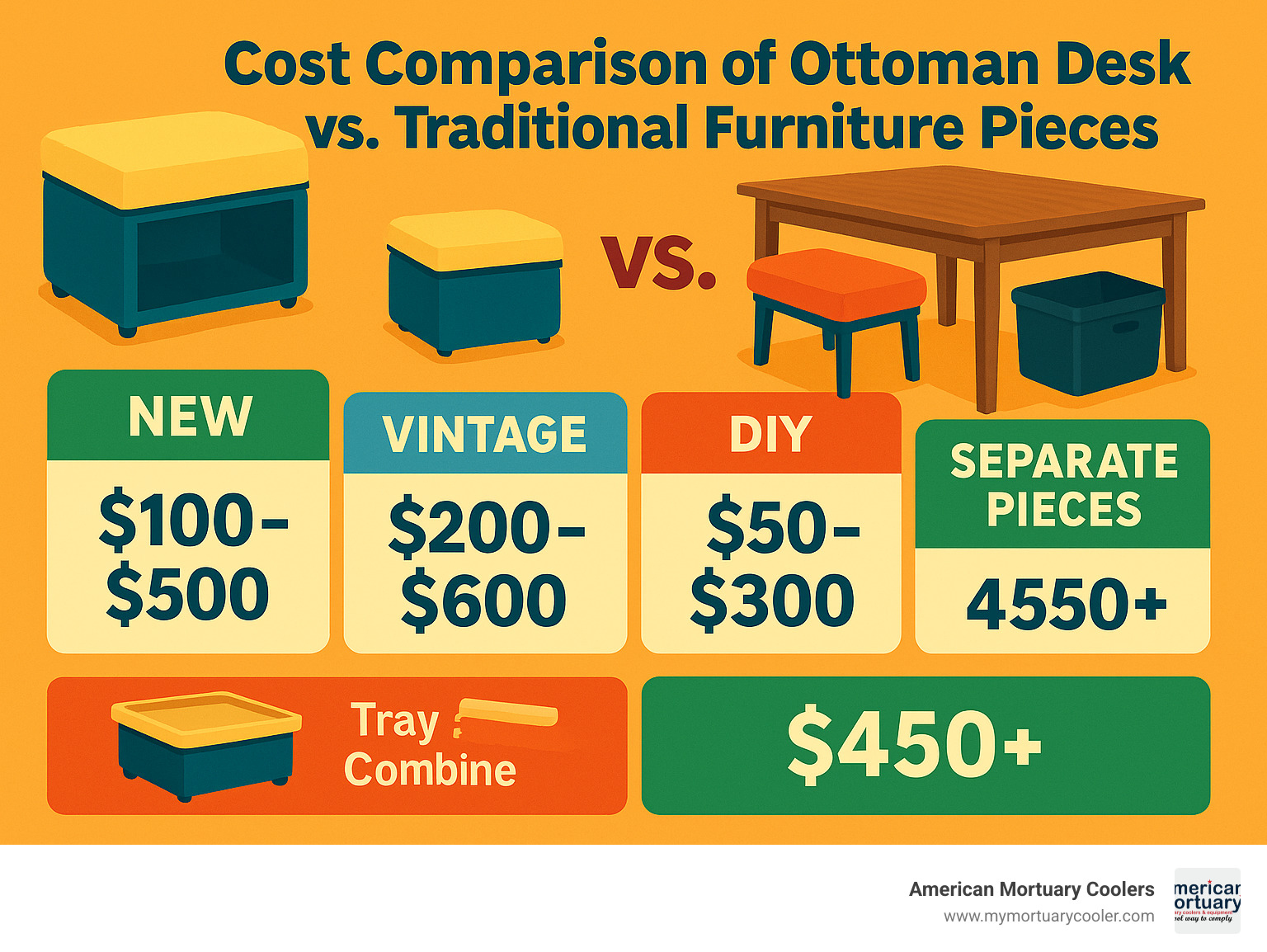
Frequently Asked Questions about Ottoman Desks
What size ottoman desk fits under a standard 30" work surface?
If you're looking to use an ottoman desk as a footrest under a standard 30-inch desk, aim for one between 14-18 inches in height. Your ideal height depends on your own height and how you sit—taller folks generally prefer taller footrests. Width is less critical but should allow comfortable leg positioning, typically 15-20 inches. Depth usually ranges from 12-15 inches to fit under the desk without protruding too far.
One smart tip: If you plan to access the storage frequently while it's under your desk, look for models with front-opening designs rather than top-opening lids, which require clearance to open upward.
Can an ottoman desk really replace a chair and a desk?
An ottoman desk can definitely replace a traditional desk setup for certain activities, but with some limitations. It excels for laptop work sessions of 1-2 hours, writing, bill paying, creative activities like sketching, and reading or research.
However, it's not ideal for full 8-hour workdays (your back will let you know!), setups requiring multiple monitors, activities needing expansive desk space, or specialized workstations.
Many remote workers find the perfect balance by using an ottoman desk as a secondary workspace. As one telecommuter shared: "I use my traditional desk for video calls and intensive projects, but my ottoman desk is perfect for reading reports or answering emails from my comfy living room. It's about having options rather than limitations."
How do I know my ottoman desk is sustainably made?
In our increasingly eco-conscious world, verifying the sustainability of your ottoman desk is important. Look for these concrete indicators:
Specific certifications offer the most reliable verification—FSC certification for wood components ensures responsible forestry practices, while OEKO-TEX for textiles and GREENGUARD for low chemical emissions protect indoor air quality.
Material transparency matters too. Reputable manufacturers clearly state what materials they use, including wood sources, fabric compositions, foam types, and finish treatments.
Manufacturing practices make a difference—look for information about local production (which reduces transportation impact), renewable energy use, and waste reduction programs.
Even packaging details reveal sustainability commitment through minimal materials, recycled content, and biodegradable protective coverings.
"Don't hesitate to contact companies directly with specific sustainability questions," suggests environmental consultant Sophia Wang. "Their willingness to provide detailed answers often reveals genuine commitment versus surface-level 'greenwashing.'"
For more guidance on maximizing limited space in your home or office, explore our other guides on room equipment, registration stands, and folding chairs for schools.
Conclusion
The ottoman desk truly shines as a clever solution for anyone trying to make the most of limited living space. I've been fascinated watching this piece evolve from its historical roots as a portable writing surface to today's smart, multifunctional designs that adapt to our changing work and living patterns.
If you're considering adding an ottoman desk to your home, take a moment to think about how you'll mainly use it. Will it be your occasional workspace when inspiration strikes? A regular seat for guests? Or perhaps primarily a storage solution for keeping your living space tidy? Your intended use should guide your selection.
Remember to measure your space carefully before purchasing. Nothing's more frustrating than bringing home the perfect piece only to find it doesn't quite fit where you planned. Pay attention to both the ottoman's footprint and the clearance needed to open lids or access storage.
The quality of materials and construction should match how heavily you'll use your ottoman desk. If it'll serve as daily seating and a frequent workspace, investing in higher-quality materials makes sense. For occasional use, more budget-friendly options might serve you perfectly well.
Don't overlook style! Your ottoman desk should complement your existing décor rather than clash with it. With so many finishes and upholstery options available, you can find one that feels like it was made for your space.
For the environmentally conscious, many manufacturers now offer sustainable options with certified materials and responsible production practices. These choices let you enjoy the functionality of an ottoman desk while honoring your values.
Consider which special features might improve your experience – adjustable heights, divided storage compartments, cable management, or removable trays can make a world of difference depending on how you'll use your piece.
At American Mortuary Coolers, we understand the importance of making every square foot count. While our main focus is providing custom mortuary coolers and equipment to funeral homes across the 48 contiguous states, we appreciate thoughtful design that maximizes functionality in limited spaces.
The ottoman desk embodies what we value in good design – it's practical, efficient, and adapts to changing needs. Whether you're carving out a workspace in a tiny apartment, creating a study area in a cramped dorm room, or simply looking for furniture that multitasks as well as you do, an ottoman desk offers an neat solution.
For more guides on making the most of limited square footage in various settings, explore our other resources like our guides to space-saving dressing tables or your one-stop shop for mortuary coolers. Whether you're setting up a professional space or your personal sanctuary, versatile pieces like the ottoman desk help you do more with less – something we can all appreciate in today's space-conscious world.


















